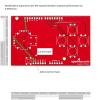namespace Bug
{
public class Program
{
public static void Main()
{
// write your code here
int xValue = 0;
int yValue = 0;
AnalogInput xvar = new AnalogInput(Pins.GPIO_PIN_A0);
AnalogInput yvar = new AnalogInput(Pins.GPIO_PIN_A1);
xvar.SetRange(0, 0xffff);
yvar.SetRange(0, 0xFFFF);
while (true)
{
yValue = yvar.Read();
xValue = xvar.Read(); //Debugger hangs here and never recovers.
}
}
}
}
So far the only remedial action I have found is to totally erase the Neduino and reflash it.
1. Am I doing something wrong in the code?
2. Is there a safer/better recovery than totally erasing the Netduino?
Help.








